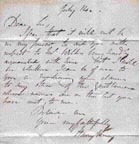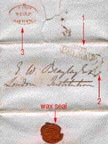These letters graciously have been shared with the Victorian Web by Eunice and Ron Shanahan; they have been taken from their website. The letters give an insight into the daily lives and concerns of 'ordinary' people without whom history would not exist. The letters are a wonderful example of how much history may be gleaned from such sources.
Click on thumbnails for larger images.]
This letter is a London Twopenny Post letter of over 170 years old — a very short one but shows how much information can be found in addition to the interesting postmarks. The paper itself is gilt-edged and bears the watermark J. WHATMAN TURKEY MILL 1832. This company still makes paper and has a most interesting website.
The letter is dated July 14 1834 and is addressed to E.W. Brayley Esq, London Institution
Postal markings:
- Boxed two-line T.P. Pall-Mall in black — this was a Twopenny Post Receiving office in the Town area of the London Twopenny Post under the Westminster Office from 1793 to 31 December 1838, when it was closed.
- Hand-stamp 2 charge mark of the type applied to all unpaid letters received in and/or for delivery in the Twopenny Post area from 1801.
- Oval transfer stamp NIGHT JY-14 1834. This would have been applied at the Chief Office of the Twopenny Post — identifiable by the month being before the day. This example has been incompletely struck so that the hour is not visible but in 1834 it was 7 p.m. so it should have a 7 either side of the word NIGHT. It would have been transferred from the Pall Mall Receiving Office to the Chief Office for delivery to Finsbury Circus, which is where the London Institution was situated.

Since this letter was before the use of envelopes, the letter was sealed with a wax impression of a signet ring of the writer, showing an eagle with outspread wings facing a rising sun, with a small shield beside it and on the right hand side a coronet. Underneath in a scroll is the motto which is rather hard to read but appears to be UNC ... SOLIEL. Unfortunately it is almost impossible to reproduce this type of seal. The letter obviously is personal and not written by his secretary.
Dear Sir,
I fear that it will not be in my power to aid you with respect to Mr Wilks, being hardly acquainted with him, but I will see whether I can be of use to you in mentioning your claims to any other of the gentlemen whose names are on the list you have sent to me.
Believe me,
Yours very faithfully
Harry Verney
This was written by Sir Harry Verney, Baronet, who was the Liberal Member of Parliament for Buckingham and a member of the House of Commons for 52 years. At his political jubilee celebrations were attended by members of both sides of the House of Commons — when the Duke of Argyll described him as “a rare example of the soundest and best kind of relationship between those who represent and those who are represented in parliament”.
The records show that he had a really interesting life, had travelled widely, and was the last in the line of Verneys, who had served the Borough of Buckingham in Parliament since the time of Edward VI (1537-1553). He was a good landlord, and a far-seeing man who lived an active life, who rode his pony up till a week before his death in 1894 at the age of 92. One possibly more publicised claim to this man's fame is that in 1857 he proposed to Florence Nightingale, who was then 37 years old, but after spending some time at Embley Park, he reportedly fell in love with her sister Frances Parthenope and married her the next year.
However, a different version of this proposal is that Sir Harry proposed by letter, but addressed his letter incorrectly to Miss Nightingale, and as Parthenope was the elder sister, that was her title. He should have addressed it Miss Florence Nightingale, for the younger sister. As the letter was addressed to her, Parthenope opened it, and accepted his proposal. After they were married they lived at his home in Buckinghamshire, Claydon House, and this house and family were an important part of Florence Nightingale's life.
The next point to check was the addressee, and I found out that Edward Wedlake Brayley (1773-1854) was a very well known author of topographical books including among others A Topographical History of Surrey.
I found more information about him on the website of the Geological Society — the address of the President 1st February 1870
Edward Wedlake Brayley, F.R.S., F.L.S., for many years Librarian to the London Institution, was a pupil of Prof. Brande at the Royal Institution, and as early as the year 1824 published, in the Philosophical Magazine, a paper on luminous meteors, a subject which occupied his attention nearly to the close of his life. His principal contribution to our science is his paper on the formation of rock-basins, published in the Philosophical Magazine in 1830. Mr. Brayley possessed a wide range of knowledge, and his printed memoirs, although not numerous, include papers on Physics, Astronomy, Chemistry, Zoology, and Meteorology. He died rather suddenly on the 1st of February, 1870.
Then I wondered if I could find anything about the London Institution itself, and sure enough, I found that as well, in Weinreb & Hibbert's London Encyclopaedia (Macmillan, 1987) p.475,
The London Institution was at Finsbury Circus. It was founded in 1806 for the Advancement of Literature and Diffusion of Useful Knowledge. Originally meeting in a house in Old Jewry, it moved into a house designed by William Brooks on the North side of Finsbury Circus in 1819. Its library was celebrated for topographical books. Lectures were given at the Institution by eminent scientific and literary men. The building was demolished in 1936.
So the only thing that I could not find out was what Mr Brayley wanted Sir Harry Verney to do for him. I wonder if he was approached because he was a personality who may have had some influence, or whether he was Mr Brayley's local MP. I don't suppose I will ever find out.
Sources
Brumell, G. The Local Posts of London 1680-1840.
Dictionary of National Biography
Members of the internet mailing list for English local history : Dr. G.P. Moss, Michael Holland, Eve McLaughlin, author of the McLaughlin Guides for family historians .
Last modified 14 February 2005
